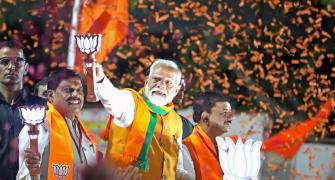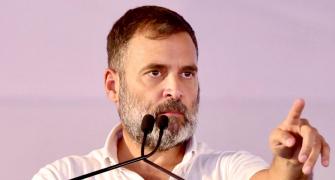If you are one of those investors looking for cheap bank stocks, then the initial public offer (IPO) of Indian Bank is for you.
After experiencing a rally in the recent past, most of the banking stocks especially private banks and some bigger public sector banks look fairly valued for the next year except a few, say analysts.
In this scenario, Indian Bank's IPO provides an opportunity to investors for bargain hunting as the issue is reasonably priced and its valuation is at par with or slightly below its nearest peers, feel analysts.
However, investors are unlikely to make great returns, as analysts are only positive and not bullish on the bank. Moreover, the bank has come out of its weak financials, thanks to a major restructuring exercise done in 2000 and is on a robust growth path since then.
The Tamil Nadu-based public sector bank plans to offer 8.6 crore shares in the price band of Rs 77-91 to raise Rs 661-782 crore. It plans to augment its capital base resulting from Basel-II norms and growth in assets as it expands its operations.
A common man's bank
With a major concentration in Tamil Nadu (about 45 per cent of total branches are in the state), Indian Bank has a good network of 1408 branches and about 500 delivery points such as extension counters, ATMs and satellite offices serving around 1.5 crore customers.
Its branches are well spread across rural, semi-urban, urban areas (including metros) in India. Besides all branches being fully computerised, over 50 per cent of the branches forming about 84 per cent of business is under core banking solution (CBS).
Further it has received additional license of 45 branches, which it plans to open across various regions. The bank also has presence in Singapore and Colombo before India's independence. However, the concentration has been in India with international business contributing less than 10 per cent.
The bank has a strategy to reach and cater to common man's financial needs and make them more bankable. It has been active in financing self help groups.
Says KC Chakrabarty, chairman, Indian Bank, "We want to be a common man's bank and our focus is on the customer in rural and under-privileged of the urban areas. This we are trying to achieve through technology and wide array of products." The bank is opening a branch in Dharavi, a slum area in Mumbai.
Will returns be uncommon?
Deposits and advances have grown at a CAGR of 13.5 per cent and 19 per cent respectively in the last five years--which is a little lower than the industry average growth of about 15 per cent in deposits and over 20 per cent of advances. The bank expects to grow both deposits at 17-18 per cent and advances at 20-25 per cent in the next few years.
To achieve this, the focus will be on CASA (current and savings bank account) on the deposit side and for growing advances, the concentration will continue to be on the agriculture, retail and SMEs which already form a major share of 65 per cent of the total loan portfolio.
The loan portfolio break-up should more or less be the same though volumes will be provided by corporate loans which form about 30 per cent. CASA currently forms 35 per cent as on September 2006, which the bank management plans to increase in future. This will help the already stable cost of funds.
Moreover, it is in a position to pass on the costs as it is operating in a lower income market where competition is less. Thus, despite competitive pressures and rising interest rates, the bank has been able to maintain its net interest margin over the past few years.
Despite positives like stable margins and a good branch network, there are certain concerns, which the bank has to take care of. A higher proportion of its total income -- around 37 per cent as on September 2006 -- comes from treasury and a substantial portion of about 47 per cent lies in the AFS (available for sale) category.
If securities are kept in the AFS category, then the bank has to bear the mark to market losses as interest rates rise, which affects the profitability. In a rising interest rate scenario, this is a major risk.
In order to reduce the dependence on treasury, the bank plans to increase advances. Chakrabarty points out, "Our low credit to deposit ratio of about 58 per cent as compared to industry average of 68-69 per cent for scheduled commercial banks gives us headroom to increase our advances."
Further, a major portion of the bank's other income has been from profit on sale of investments and recovery from written off accounts. The bank has six asset recovery branches and has a good track record for recovery in the past. When the recoveries are done, it directly gets added to the bottom line. However, it is not a stable source of income.
Strong financials
The company's has reported strong financial performance since its restructuring in 2000, thanks to government's financial aid and serious management efforts.
Though business (deposits plus advances) and balance sheet size have grown at a CAGR of over 15 per cent each in the last four years, its profitability has improved at an even higher rate of 26 per cent and 91 per cent in case of operating and net profit, respectively.
Even in H1 FY07, despite 57 per cent year-on-year rise in provision and contingency, the bank's operating and net profit jumped over 40 per cent each, thanks to a robust 23 per cent rise in net interest income, a modest 11 per cent increase in other income and a marginal 4 per cent change in operating expenses.
Net interest margin also improved by 10 basis points y-o-y. Thus, looking at the past few year's financial performance, there is nothing much to worry.
Right price
The issue is priced at around 0.97-1.15 times and at 0.83-0.98 times its estimated FY07 and FY08 book value respectively in the given price band and is comparable with its nearest peers like Allahabad Bank, Indian Overseas Bank and Andhra Bank.
Both Ravikant Bhatt of IDBI Capital and Kashyap Jhaveri of Emkay Shares and Stock Brokers are positive about the bank's public issue especially from the valuations point of view.
However, liquidity on the counter could be constrained as post-issue, the government will continue to hold a massive 80 per cent. Investors can expect decent returns from this bank.
- Issue opened: February 5, 2007
- Issue closes: February 9, 2007








